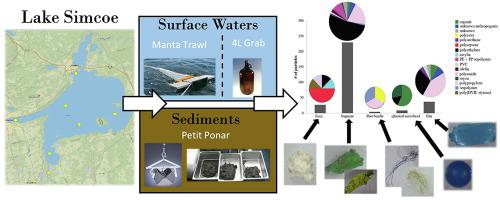Journal of Great Lakes Research ( IF 2.2 ) Pub Date : 2020-11-29 , DOI: 10.1016/j.jglr.2020.10.007 Miguel Eduardo L. Felismino , Paul A. Helm , Chelsea M. Rochman

|
Microplastics (plastic particles <5 mm in size) have been reported in ecosystems worldwide and have been shown to cause adverse negative impacts on organisms. This study provides the first report of microplastics and other anthropogenic microparticles in the surface waters and sediments of Lake Simcoe in Ontario, Canada, a popular recreational and fishing lake. Surface waters (low volume grabs and manta trawls) and sediments were sampled from eight sites to determine microparticle abundances and character (size, morphology, material identity). Concentrations ranged from 0 to 0.7 particles/L in surface water grab samples, 0.4–1.3 particles/m3 in manta trawl samples, and 8.3–1070 particles/kg in sediment samples. Spectroscopic analysis confirmed that 72% of particles were anthropogenic, with 64% unambiguously identified as microplastics. However, confirmed microplastic concentrations were approximately 6–7 times lower than unadjusted counts in sediments, demonstrating the importance of verifying and adjusting reported values. Fibers were only quantified and characterized in surface water grab samples and sediments, and were the most common morphology, accounting for 82% and 89% of anthropogenic particles, respectively. Fragments were most common in manta trawl samples (75%, excluding fibers) and consisted predominantly of polyethylene (41%) and polypropylene (22%). The influence of proximity to urban centers and prevailing winds on the distribution of microplastics was apparent in surface water manta trawls. Microplastics and other anthropogenic microparticles are present in Lake Simcoe but at lower abundances than at locations impacted by larger population centers in other large freshwater lakes such as Lakes Ontario and Erie of the Great Lakes.
中文翻译:

西姆科湖水和沉积物中的微塑性和其他人为微粒
在世界各地的生态系统中均已报道了微塑料(尺寸小于5毫米的塑料颗粒),并已证明会对生物造成不利的负面影响。这项研究首次报道了加拿大安大略省辛科湖(一种受欢迎的休闲和垂钓湖)的地表水和沉积物中的微塑料和其他人为微粒。从八个地点取样地表水(低容量抓斗和蝠ta)和沉积物,以确定微粒的丰度和特征(大小,形态,物质特性)。地表水抓取样品的浓度范围从0到0.7颗粒/L,0.4-1.3颗粒/ m 3蝠man样本中的含量为8.3–1070颗粒/ kg。光谱分析证实72%的颗粒是人为的,而64%的颗粒被明确地确定为微塑料。但是,已确认的微塑性浓度比未调整的沉积物计数低大约6至7倍,这表明验证和调整报告值的重要性。纤维仅在地表水捕获样品和沉积物中进行定量和表征,并且是最常见的形态,分别占人为颗粒的82%和89%。碎片在蝠ta样本中最常见(75%,不包括纤维),主要由聚乙烯(41%)和聚丙烯(22%)组成。在地表水蝠ta拖网中,靠近城市中心和盛行风对微塑料分布的影响显而易见。微塑料和其他人为微粒存在于西姆科湖中,但其丰度要比其他大型淡水湖(例如安大略湖和大湖伊利)的较大人口中心所影响的地区低。


























 京公网安备 11010802027423号
京公网安备 11010802027423号